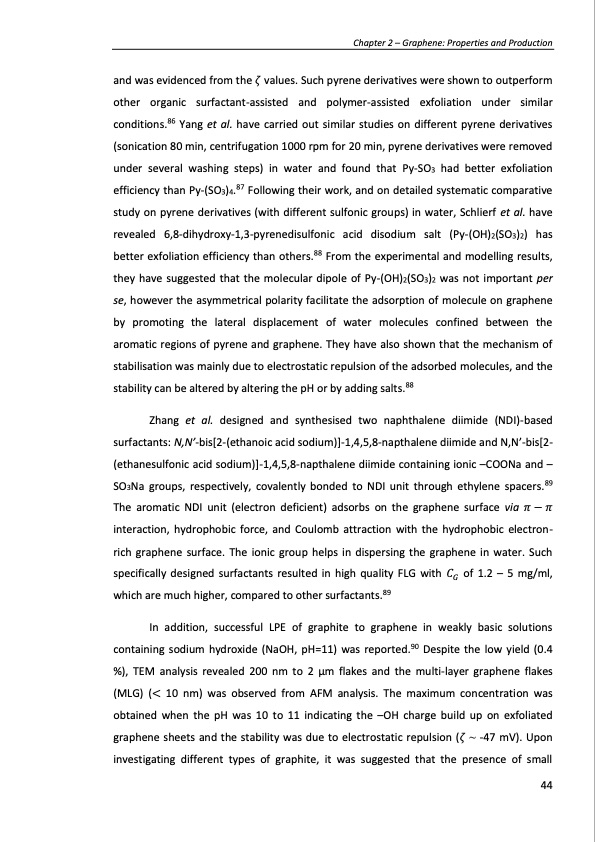PDF Publication Title:
Text from PDF Page: 044
and was evidenced from the 𝜁 values. Such pyrene derivatives were shown to outperform other organic surfactant-assisted and polymer-assisted exfoliation under similar conditions.86 Yang et al. have carried out similar studies on different pyrene derivatives (sonication 80 min, centrifugation 1000 rpm for 20 min, pyrene derivatives were removed under several washing steps) in water and found that Py-SO3 had better exfoliation efficiency than Py-(SO3)4.87 Following their work, and on detailed systematic comparative study on pyrene derivatives (with different sulfonic groups) in water, Schlierf et al. have revealed 6,8-dihydroxy-1,3-pyrenedisulfonic acid disodium salt (Py-(OH)2(SO3)2) has better exfoliation efficiency than others.88 From the experimental and modelling results, they have suggested that the molecular dipole of Py-(OH)2(SO3)2 was not important per se, however the asymmetrical polarity facilitate the adsorption of molecule on graphene by promoting the lateral displacement of water molecules confined between the aromatic regions of pyrene and graphene. They have also shown that the mechanism of stabilisation was mainly due to electrostatic repulsion of the adsorbed molecules, and the stability can be altered by altering the pH or by adding salts.88 Zhang et al. designed and synthesised two naphthalene diimide (NDI)-based surfactants: N,N’-bis[2-(ethanoic acid sodium)]-1,4,5,8-napthalene diimide and N,N’-bis[2- (ethanesulfonic acid sodium)]-1,4,5,8-napthalene diimide containing ionic –COONa and – SO3Na groups, respectively, covalently bonded to NDI unit through ethylene spacers.89 The aromatic NDI unit (electron deficient) adsorbs on the graphene surface via 𝜋 − 𝜋 interaction, hydrophobic force, and Coulomb attraction with the hydrophobic electron- rich graphene surface. The ionic group helps in dispersing the graphene in water. Such specifically designed surfactants resulted in high quality FLG with 𝐶𝐺 of 1.2 – 5 mg/ml, which are much higher, compared to other surfactants.89 In addition, successful LPE of graphite to graphene in weakly basic solutions containing sodium hydroxide (NaOH, pH=11) was reported.90 Despite the low yield (0.4 %), TEM analysis revealed 200 nm to 2 μm flakes and the multi-layer graphene flakes (MLG) (< 10 nm) was observed from AFM analysis. The maximum concentration was obtained when the pH was 10 to 11 indicating the –OH charge build up on exfoliated graphene sheets and the stability was due to electrostatic repulsion (𝜁 ~ -47 mV). Upon investigating different types of graphite, it was suggested that the presence of small Chapter 2 – Graphene: Properties and Production 44PDF Image | PRODUCTION AND APPLICATIONS OF GRAPHENE AND ITS COMPOSITES

PDF Search Title:
PRODUCTION AND APPLICATIONS OF GRAPHENE AND ITS COMPOSITESOriginal File Name Searched:
graphene-production-applications.PDFDIY PDF Search: Google It | Yahoo | Bing
Salgenx Redox Flow Battery Technology: Power up your energy storage game with Salgenx Salt Water Battery. With its advanced technology, the flow battery provides reliable, scalable, and sustainable energy storage for utility-scale projects. Upgrade to a Salgenx flow battery today and take control of your energy future.
CONTACT TEL: 608-238-6001 Email: greg@infinityturbine.com (Standard Web Page)